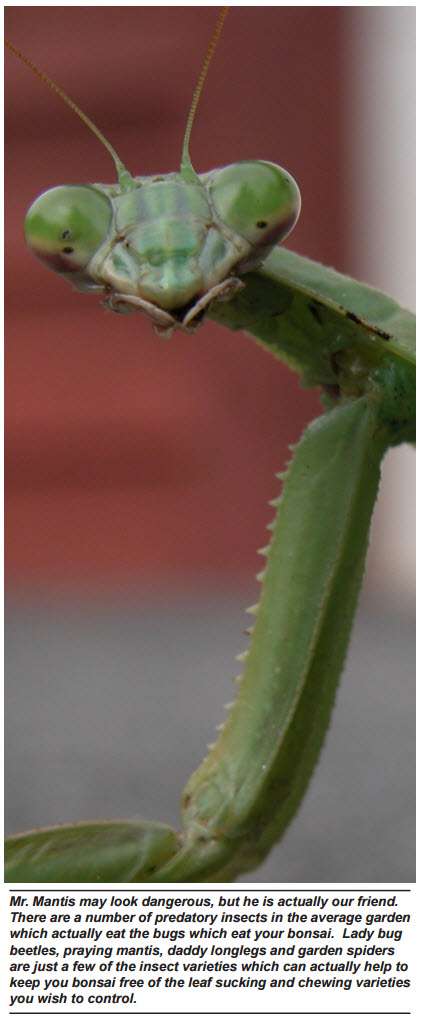The world of bonsai is not immune to insect attack. The same critters that will eat your tomatoes and your zucchini will also eat your bonsai. Insects, like death and taxes, are a fact of life and at some point you are going to have to deal with them.
Depending upon what region of the country you live in, the specific types of bugs or fungal diseases you will have to contend with may vary greatly. It is not the purpose of this chapter to give you specific solutions to specific bug problems. To do so would require many more pages than are available here. The objective here is to teach you how to efficiently identify the problem as well as resources for solving them. It is best to remember that the insect kingdom is a very large and hungry one. Forewarned is forearmed.
Treat any insect or disease problems you encounter on your bonsai without delay. By virtue of it’s small size, an outbreak of bugs or fungus can decimate a bonsai more quickly than all the other plantings in your garden. Likewise, the infestation’s spread may also be accelerated because of the close proximity each bonsai has to another on the growing benches.
Keep a close eye on your trees and deal with any problems as soon as you discover them. A daily visual inspection of the leaves, branches and soil surfaces of your bonsai is a good idea. The task is not as time consuming as it might sound and can be coupled with other regularly scheduled bonsai tasks such as watering or feeding.
I tend to regard the time I spend watering my trees each day as “quality time with the kids.” It’s a task which must be done, but I find it a most pleasurable one. As I move from tree to tree, giving each its daily drink, I also spend a moment or two “visiting” each plant, evaluating its progress and making mental notes about my plans for it in the future. Indeed, enjoying our creations and watching as they respond to the things we have done is one of the great pleasures of bonsai. Such occasions are also a good time to conduct a visual inspection of your bonsai for things that might be going wrong. Limp growing tips, spotted or yellowing leaves and needles, curling, deformed or damaged foliage and dull, flat, lusterless growth are just a few of the signs that you might have a problem.
That problem, however, may not be due to insects or fungus. Overwatering, underwatering, improper fertilization, excessive heat exposure, storm, wind and frost damage can also result in similar changes to your bonsai. If you do, however, discover the cause is a bug or fungus, you must then identify the culprit and develop a plan for dealing with it.
Many years ago, when I moved from Minnesota to North Carolina, we were delighted to discover a whole range of plant varieties suddenly available to us that had been much more problematic to cultivate in the colder climate of the northwest. Azaleas, Japanese maples, crape myrtles and wisterias all grew easily in the Carolina’s.
So did the bugs. We discovered a whole new group of multi-legged creatures that were more than willing to turn our beloved bonsai into a luncheon for themselves and their friends.
Our first response was to turn to other members of the local bonsai community with the question: “What is this thing… and how do I get rid of it?” As it turns out, this is actually a good way to begin.
Others have encountered the problem you now face and may have already found an answer. Don’t be afraid to ask someone for advice. Neighbors, fellow bonsai club members and even the wide world of the internet can often yield useful information on the best way to get aphids, beetles, mealy bugs, leaf hoppers, spider mites, caterpillars and all their other multi-legged friends to go away and stay away.
If this fails two other options are available. The first is your local county agricultural extension agent or the agricultural or entomology departments at your local University campus. They are a wonderful source of information, not only about bugs and how to kill them, but arborculture in general. A phone call or personal visit (with the bug or diseased leaf in plastic bag) to such agency will probably not only net you a solution to your problem, but also produce more information than you can reasonably absorb on topics such as “botrytis blight” or “aphidoidea infestation”.
The second course of action is to head for the library. Bug books are full of “icky” disgusting pictures, but they contain a lot of answers as well. Many of the companies that manufacture insecticides and fungicides publish books on the subject. Such books usually tout the company’s product as the answer to the problem. Their solution may or may not be a good one, but the books themselves usually are well illustrated and show the regions of the country where the pest is most commonly found, the kinds of damage it can do and the various versions it comes in. Aphids, for example come in grey, black, green, and red varieties. Spider mites also boast a well developed family tree. Likewise, caterpillars and worms come in many flavors. It is helpful to narrow the field down as much as possible.
Once you have identified the critter or disease in question, the next task becomes how to dispatch it. That’s where the controversy starts. We all agree that the bug has got to go, but we also all wish to be environmentally responsible and to avoid the release of chemical toxins into our air and ground water.
Several avenues of insect control may be open to you. Consider them all and make the best choice for your particular situation.
One of the simplest solutions is the jet nozzle on your garden hose. Many insects, aphids in particular, can simply be washed off by spraying the top and bottom surfaces of the plants leaves. Fungal problems on Chinese elms can be greatly reduced by avoiding getting the leaves wet and pruning foliage to promote good air circulation. In many cases the offending critter can be removed with a pair of tweezers or wiped away with a cotton swab dipped in rubbing alcohol. Look for a simple solution.
If the bugs are more persistent you might consider researching the large number of home remedies which are available. You know from the movies that garlic is useful for keeping away vampires, but were you aware that minced garlic combined with mineral oil, water and soap will control aphids, spider mites and white flies. Ants hate cucumber peelings. Baking soda, water and soap flakes can be used to control mildew and black spot on leaves. The list goes on and on. The internet and local library are excellent places find more information on such remedies. Do a little research and you may come up an answer to your problem that is both simple and environmentally friendly.
Finally, don’t overlook the fine selection of insecticides and fungicides available at your local nursery center. Here too, a little research is in order. Read the labels and documentation which comes with commercially available chemicals. Make sure they are specific to the bug you intend to eradicate and also that the chemical in question will not do damage to the particular variety of tree you plan to spray it on.
Most of us usually opt for the commercial bug killers. Probably because it’s quick and easy. If you do choose this route, there are two thing which you should be aware of:
First, bugs can build a resistance to a particular brand of insecticide if used repeatedly over the years. It is therefore a good idea to change the chemical you are using every couple of years. For this same reason we do not recommend that you put your bonsai on a regular spraying program. Instead, inspect your trees and apply insecticides only if and when they are required.
Finally, remember that insecticides are nondiscriminatory. They kill all the bugs. This may not be something you wish to do.
 © 2000 Bonsai Learning Center, All Rights Reserved
© 2000 Bonsai Learning Center, All Rights Reserved
